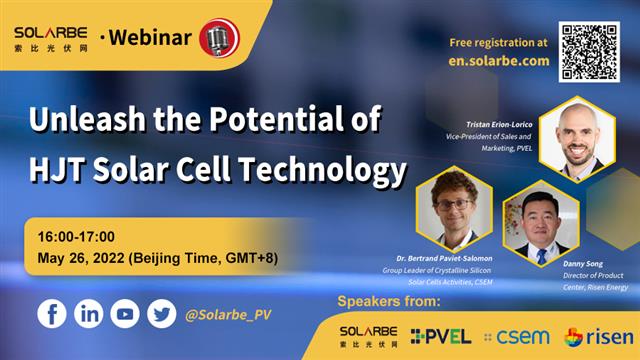Heterojunction solar cell technology has been gaining unprecedented attention this year reflection on manufacturers all expanding relevant production and speeding up technological research.
On May 10, Risen Energy celebrated the production of its first commercial heterojunction cell on 210 mm thin wafers, and announced the start of the construction of its phase II project in Changzhou, Jiangsu province. The company’s pilot plant for HJT cells has an annual production capacity of about 500 MW. It took three months to complete through upgrading existing production lines and installing new equipment. The pilot plant will be fully dedicated to the provision of cells for the company’s new HJT module series Hyper-ion.
During the interSolar Europe this year, REC Group, a photovoltaic module integration manufacturer, launched its latest Alpha Pure-R residential heterojunction module, applying heterojunction cells and G12 large-size module design. Jan Enno Bicker, CEO of REC Group, also revealed that the company’s future research and development work will focus entirely on heterojunction technology.
On May 16, HuaSun’s Himalaya 210mm series high-efficiency microcrystalline heterojunction modules have successfully obtained TüV certification, indicating its official entrance of 700W+ echelon. The company will further accelerate production expansion and plans to carry out the construction of phase III 4.8 GW bifacial microcrystalline heterojunction intelligent factory project in Xuancheng. They also announced on May 18 to invest in the construction of 5 GW high-efficiency heterojunction photovoltaic cells and modules in Dali.
With so many moves from enterprises, we, based on our previous demonstrations on overall solar technologies and perovskite, have scheduled another tech-series webinar to further discuss heterojunction solar cell techniques.
Join us at 4:00 PM on this Thursday with experts from Risen Energy, CSEM, and
PVEL to learn more about the latest findings on heterojunction solar cell
technology, as well as heterojunction cell module and relevant testing
issues!
Danny Song, Risen Energy
Song is a Master of Materials Science from Fudan University with MBA certificate from Shanghai University of Finance and Economics. Song joined the photovoltaic industry in 2006 and has successively engaged in the technology, R&D and quality of cells and modules in many Tier-1 photovoltaic enterprises. He has rich experience in the photovoltaic industry and currently serves as the Product Manager of Risen Energy.
Dr. Bertrand Paviet-Salomon, CSEM
He has received the M.Sc. degree in 2009 and the Engineer Diploma degree in theoretical and applied optics from the Institut d’Optique, Paris, France. From 2009 to 2012, he was pursuing the Ph.D. degree with the French National Institute for Solar Energy, Le-Bourget-du-Lac, France, working on laser processes for crystalline silicon solar cells. He received the Ph.D. degree in electronics and photonics from the University of Strasbourg, Strasbourg, France, in 2012. From 2012 to 2014, he was a Postdoctoral Researcher with the Photovoltaics and Thin-Film Electronics Laboratory, École Polytechnique Fédérale de Lausanne, Neuchâtel, Switzerland, working on high-efficiency back-contacted silicon heterojunction solar cells. In 2014, he joined the PV-Center, Centre Suisse d’ Électronique et de Microtechnique, Neuchâtel, Switzerland, and is since 2021 the group leader of the crystalline silicon solar cells activities there.
Tristan Erion-Lorico, PVEL
He has over 15 years of solar and electrical industry experience that spans manufacturing, testing, project development and operations and maintenance. As vice president of sales and marketing at PV Evolution Labs (PVEL), Tristan oversees PVEL's commercial activities including collaborating with PV module buyers, investors and manufacturers to develop innovative test programs for product qualification.



